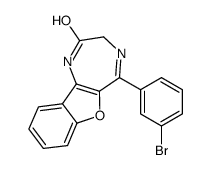5-BDBD

5-BDBD structure
|
Common Name | 5-BDBD | ||
|---|---|---|---|---|
| CAS Number | 768404-03-1 | Molecular Weight | 355.18500 | |
| Density | N/A | Boiling Point | N/A | |
| Molecular Formula | C17H11BrN2O2 | Melting Point | N/A | |
| MSDS | Chinese USA | Flash Point | N/A | |
| Symbol |

GHS07 |
Signal Word | Warning | |
Use of 5-BDBD5-BDBD, a potent and selective P2X4 receptor antagonist, inhibits rP2X4R-mediated currents, with an IC50 of 0.75 μM. 5-BDBD completely blocks the basal and acute hyperalgesia induced by nitroglycerin (NTG)[1][2]. |
| Name | 5-(3-bromophenyl)-1,3-dihydro-[1]benzofuro[3,2-e][1,4]diazepin-2-one |
|---|---|
| Synonym | More Synonyms |
| Description | 5-BDBD, a potent and selective P2X4 receptor antagonist, inhibits rP2X4R-mediated currents, with an IC50 of 0.75 μM. 5-BDBD completely blocks the basal and acute hyperalgesia induced by nitroglycerin (NTG)[1][2]. |
|---|---|
| Related Catalog | |
| Target |
I50: 0.75 μM (P2X4 receptor) |
| In Vitro | 5-BDBD inhibits 10 µM ATP-induced currents of rP2X4R-expressing HEK293 cells in a concentration-dependent manner, with an IC50 of 0.75 μM[1]. 5-BDBD displaces rightward the ATP concentration-response curve, with an EC50 of 4.7 to 15.9 μM[1]. 5-BDBD could be specifically used to discriminate between P2X1R, P2X2aR, P2X2bR, P2X3R, P2X4R, and P2X7R[1]. |
| In Vivo | 5-BDBD (28 mg/kg; i.p.; daily for 9 days) can completely blocke the basal hyperalgesia induced by recurrent NTG injection[2]. Animal Model: Male C57BL/6 mice[2] Dosage: 28 mg/kg Administration: I.p.; daily for 9 days Result: Prevented NTG-induced mechanical hypersensitivity. |
| References |
| Molecular Formula | C17H11BrN2O2 |
|---|---|
| Molecular Weight | 355.18500 |
| Exact Mass | 354.00000 |
| PSA | 58.09000 |
| LogP | 3.50550 |
| InChIKey | NKYMVQPXXTZHSF-UHFFFAOYSA-N |
| SMILES | O=C1CN=C(c2cccc(Br)c2)c2oc3ccccc3c2N1 |
|
Autocrine Regulation of UVA-Induced IL-6 Production via Release of ATP and Activation of P2Y Receptors.
PLoS ONE 10 , e0127919, (2015) Extracellular nucleotides, such as ATP, are released from cells in response to various stimuli and act as intercellular signaling molecules through activation of P2 receptors. Exposure to the ultravio... |
|
|
Effect of P2X4R on airway inflammation and airway remodeling in allergic airway challenge in mice.
Mol. Med. Report. 13 , 697-704, (2015) P2X4 receptor (P2X4R) is the most widely expressed subtype of the P2XRs in the purinergic receptor family. Adenosine triphosphate (ATP), a ligand for this receptor, has been implicated in the pathogen... |
| 5-bdbd |